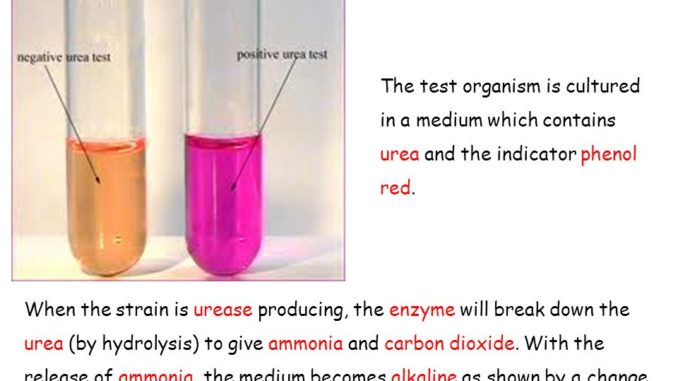
Urease test:
Objective
- to check whether the organism can produce urease enzyme for the degradation of urea or not.
Principle of urease test:
Urea is common metabolic waste product of protein digestion in most vertebrates that is toxic to most living organism. Urease catalyses the breakdown of urea into ammonia and carbondioxide. The test organism is cultured in a medium containing urea and the indicator phenol red. If the bacterial strain is urease-producing, the enzyme will hydrolyse the urea to give ammonia and carbondioxide. With the release of ammonia, the medium become alkaline shown by change in color of indicator to reddish pink.
Urea + H2O———–urease enzyme———>Ammonia + CO2
This test is done to determine the ability of certain micro organism to produce enzyme urease. It is one of the useful diagnostics for identifying bacteria, particularly Proteus from other gram negative bacteria.
The basic principle of this test is to check the color change of indicator phenol red used in the media caused due to the degradation of urea and formation of basic product i.e NH3. The change in the color of the medium from orange to pink red due to the rise in pH indicates the positive test, while the unchanged color of media indicates negative test.
Requirements
- Cristensen’s Urea broth or MIU ( mortility indole urea) medium
- Bacterial culture; Proteus and E.coli
Procedure of urease test:
- Prepare an Urea broth by dissolving 2.95g of urea powder in 150ml of distilled water. Add urea after autoclaving the media to prevent urea from initial breakdown.
- Inoculate the given sample of organism aseptically using wire loop.
- Incubate the tubes at 37°C for 24 hours.
- Observe the result
Result:

Urease test Positive: Red-pink color ( Proteus vulgaris)
Urease test Negative: No pink color ( E. coli)
Urease Producig bacteria:
- Proteus spp
- Klebsiella spp
- Morganella spp
- Providentia spp
- Serratia spp
- Staphylococcus saprophyticus
- Bacillus spp
- Mycoplasma
- Ureaplasma urealyticum
- Nocardia
- Corynebacterium urealyticum
- Helicobacter pylori
